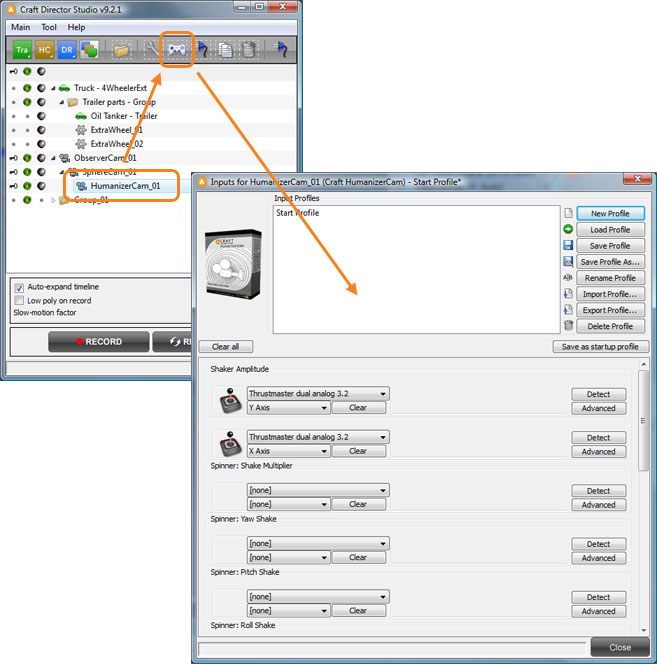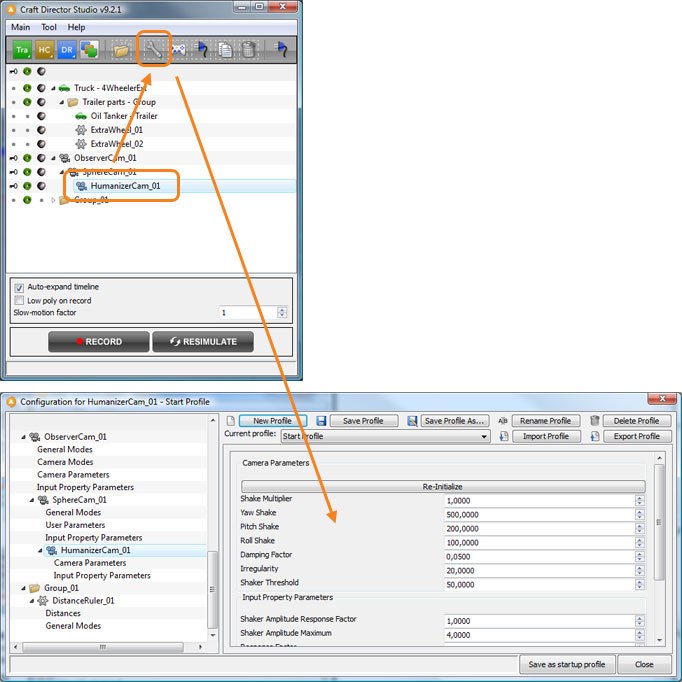
Using Craft Missile
 Optimizing the scene Optimizing the scene
It’s wise to optimize the scene before starting to recording the animation. The scene is optimized by decreasing the amount of polygons shown during the recording. This is achieved by hiding objects not crucial to the part of the scene to be animated. Another tip is to use Craft Bounding Poly, which temporary lowers the amount of polygons for selected objects and allows for a smoother recording. |
- Create a Craft Missile.
- Configure the input settings for Craft Missile.
- Select Missile in the tool tree list and click on the Input Settings button in Craft Director Studio’s main window. This will open the Input Settings window for Craft Missile.

- Select Missile in the tool tree list and click on the Input Settings button in Craft Director Studio’s main window. This will open the Input Settings window for Craft Missile.
- Place Craft Missile in the same position as the high-poly model of your missile.
- Scale the Craft Missile so it is the same size as the model.

- Link/Parent the model to Missile_01_BodyRelocatorMesh.
- Place the Missile_01_TargetSphereMesh on the target. The TargetSphereMesh can be scaled non-uniformly in order to match the shape of the target area. If you have a moving target, then link/parent Missile_01_TargetSphereMesh to the target object.

- If scene is too complex, the recording will be slow and choppy. It is therefore advisable that you hide the high-poly model of the missile until after the animation is finished (
 ).
). - Press Record in the Craft Director Studio interface in order to start the recording.
- Use your pre-determined Fire Missile button (in the Input settings window) to fire the missile. Craft Missile’s motion will be recorded and key-framed during the recording. Press Stop to end the recording.
- Unhide your high-poly model (
 ).
). - Render.
If you want to use the FlameMesh to create an ignition flame for the missile, you can follow the following easy steps:
- Ensure that the FlameMesh is renderable (in the object properties).
- Add texture coordinates for the FlameMesh (us a UVW Map in 3ds Max).
- Add a gradient map as a texture for the FlameMesh.
- Render.

Input settings

Fire Missile
This button will fire the missile.
Spinner…
Spinners enables the change of parameter values with an input controller in real-time.
Configuration

General Modes
Hide Helpers
Hides the helper objects.
Hide Helpers during Recording
Hides the helpers during recording.
Hide Rear Camera
Hides the camera which follows the missile from behind.
Missile Modes
Use Guided Missile
When this option is activated the Missile_01_MissileMesh will seek out the Missile_01_TargetSphereMesh.
Quit Guiding if Target is Missed
The missile will not continue to seek out the Missile_01_TargetSphereMesh if it misses or passes the target. The missile will then continue in the same heading it was on.
Add Parents Initial Speed to Maximum Speed
When the missile is fired from a moving object (like an airplane) this option will add the parent’s speed to the missile’s maximum speed if the missile is bound to the parent.
Fire Missile at Current Frame
The missile is fired as soon as you press record, from the current frame.
Fire Nth time
Fires the missile the Nth time the Fire Missile button is pressed. This can be used if you have more than one missile you want to fire during the same scene using the same fire button.
Guided Missile Parameters
Guidance Strength (%/sec)
This determines how strongly the missile is guided, i.e. how much of the total required heading correction is executed in the space of a second (0-100%).
Guidance Limiter (rads/sec)
This setting limits size of the heading correction that can be executed in the space of a second.
Target Speed Compensation
This setting allows the missile to aim in front of a moving target’s current position – i.e. to aim for where the target will be. A high value enables the missile to track a very fast moving target. With a value of 0 the missile will aim straight at the target’s current position, but will have difficulty hitting a moving target.
Unguided Flight Time
This is the amount of time after the missile is launched and has ignited but still is not guided. Use Guided Missile must be selected for this configuration to have any effect.
Physical Parameters
Maximum Speed
The maximum speed of the missile.
Acceleration
How fast the missile accelerates.
Mass
This is used to simulate the weight of the missile.
Ignition Time
Time between launch and ignition.
Gravity
Determines how much effect gravity will have on the missile.
Time to Compensate for Gravity
Time it takes before the missile has enough propulsion to compensate for gravity.
Time to Eliminate Initial Speeds
The time (in seconds) it takes for the missile no longer to be affected by the initial speed it inherits from a parent.
Initial Speed (%)
The speed at which the missile is expelled from, for example, the wing of a fighter jet. The value is given as a percentage of the missile’s Maximum Speed (0-100%).
Turbulence Strength
How much the missile is affected by turbulence.
Turbulence Roughness
A lower value means that the missile is affected by air turbulence in a smoother motion.
Propulsion Flame Parameters
Propulsion Flame Spin
Determines the rotation speed for the propulsion flame of the missile.
Propulsion Flame Scale
Determines the scale of the propulsion flame.